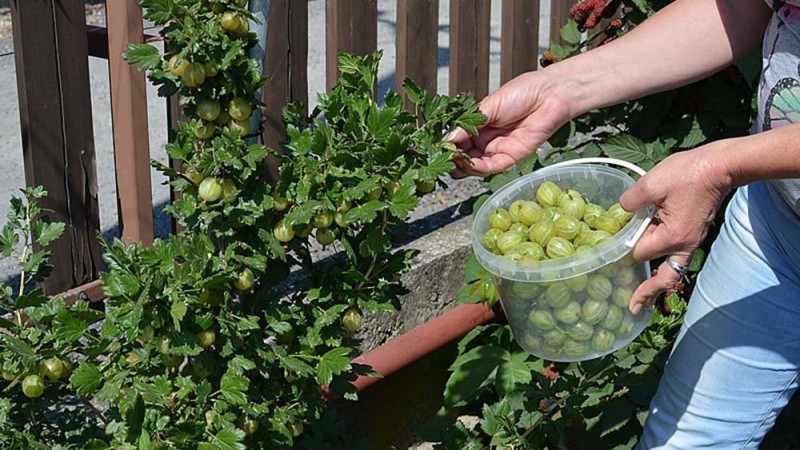
If you’re looking to add another delicious and nutritious fruit to your garden, look no further than gooseberries. These small, aromatic, sweet-tart berries are not only a delight to eat, but they’re also relatively easy to grow. In this article, we’ll provide you with step-by-step instructions on how to successfully grow gooseberries in your own garden.
Choose the Right Plant
When choosing a gooseberry shrub, look for a proven, disease-resistant variety from a reputable nursery. It should be a healthy, potted shrub with strong roots, undamaged leaves, and well-spaced branches.
Find the Perfect Location
Gooseberries thrive in full sun or partial shade, so choose a spot in your garden that gets at least six hours of direct sunlight each day. The soil should be fertile, well-draining, and slightly acidic with a pH between 6.0 and 6.5.
Planting
Gooseberry shrubs are planted 0.8-1 m apart in a row. Gooseberries on a trunk are planted 1.0-1.2 m apart in a row.
- Dig a hole twice as wide as the root ball and twice as deep as the original container in which the gooseberry grew.
- Gently remove the shrub from the container and place it in the dug hole.
- Backfill the hole with soil and tamp it down gently to remove air bubbles.
- Water thoroughly to settle the soil around the roots.
- Do not apply any fertilizer when planting.
Remember that gooseberries on a trunk need a strong support stake that will not break under the weight of the crop. The best option is an iron rod with a minimum diameter of 2 cm.
Pruning and Training
Gooseberries are grown as a shrub or on a trunk, but compared to currants, growing on a trunk is considered a better shape, which allows for easier harvesting and care. Unlike currants, gooseberries bear fruit mainly on one-year-old wood, so new shoots must develop year after year.
Correct pruning is essential for optimal growth and fruit formation in gooseberries. Here's how to do it:
- In the first year, cut off the top third of each shoot to encourage branching. In the summer, let the shrub grow freely.
- In the second year, select 4 to 6 suitably spaced strong shoots as the basis for future branches. Cut the remaining shoots from the base.
- In subsequent years, increase the number of branches by 2 to 3, and in the following year by another 2 to 3. From the 4th to the 5th year, begin to gradually replace the branches with younger shoots. Shortening annual shoots in subsequent years is generally not necessary. Prune to maintain an open and airy shape of the shrubs, which will allow better air circulation and reduce the risk of disease.
Fertilization and Mulching
A few weeks before planting gooseberries, incorporate organic matter into the soil, such as green manure, compost or thoroughly rotted manure. The autumn term is better for organic fertilization than spring. Always use organic fertilizer as an essential basis and mineral fertilizers, whether water-soluble or granular, as a necessary nutritional supplement. The combination of organic and mineral fertilizers will effectively support healthy growth of the shrub and sufficient fruit production. Follow the manufacturer's instructions for application rates.
Mulching the soil with various organic materials has a very positive effect on the growth and fertility of gooseberries. The layer of organic material forming the mulch must be constantly replenished during the vegetation period because it is constantly decreasing due to the activity of soil macro and microorganisms.
Harvesting
Depending on the variety, gooseberries typically ripen from late june to end of july. Harvest the berries when they are fully colored and slightly soft to the touch. Harvested berries can be eaten fresh, used in pies, jams, or preserves, or frozen for later use.
Diseases and Pests
Gooseberries can be susceptible to a variety of diseases and pests. One common disease is American gooseberry mildew (Podosphaera mors-uvae), which appears as a white powdery coating on the leaves and stems. To prevent this, choose disease-resistant gooseberry varieties that are bred to resist this particular disease. In addition, ensure proper air circulation between the branches by pruning and spacing the shrubs appropriately.
Resistant Gooseberry Varieties
If you live in an area where American gooseberry mildew is prevalent, consider planting resistant gooseberry varieties. Popular disease-resistant varieties include 'Neslukhovsky', 'Invicta', 'Pax', 'Rodnik' and 'Kameniar'. These varieties are less likely to be affected by disease, making them a good choice for trouble-free growing.
And finally
Growing gooseberries can be a rewarding experience for both novice and experienced gardeners. By choosing the right variety, planting in the ideal location, and implementing the right pruning and fertilizing techniques, you'll be on your way to a bountiful harvest of delicious gooseberries. Be sure to watch out for diseases and pests, and consider planting resistant varieties to minimize any potential problems. With a little time and care, you can enjoy the sweet and tangy flavors of homegrown gooseberries right from your own garden.









